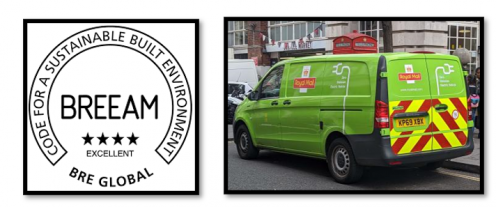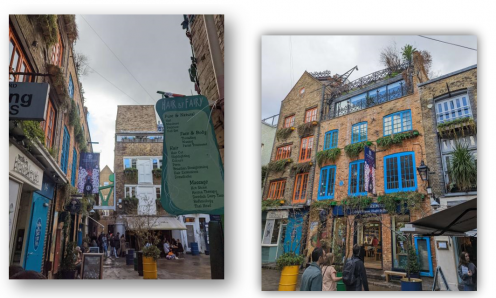London is a city steeped in history and culture, but it is also at the forefront of sustainable living. The capital was recently voted as the 6th most sustainable city in the world by the Arcadis Index 2022. I was lucky enough to be part of a guided tour that emphasized the city’s efforts to live sustainably. My name is Shashwat and being an international student who started university during peak COVID season, I was still quite unfamiliar with the quaint alleys and shops around Central London. Arranged and led by the leaders of “Designing a Sustainable World” module, Dr Pooja Basnett and Dr Linda Percy, the field trip truly helped me observe the city’s meticulously planned infrastructure in a new light.

The tour began outside the Dominion Theatre right next to Tottenham Court Road station, where our guides, Maciek and Valentina, greeted us and introduced us to the concept of a sustainable city. We were amazed at the green credentials of the London skyline with some key examples of sustainable architecture. The tour took us to some of the city’s most iconic buildings, each with their unique contribution to sustainability. As we progressed through the tour, we were taken to the heart of public policy initiatives seeking to tackle the greatest challenges of our time. Valentina explained the controversial policies that sought to address the acute problems faced by London as a densely populated and historic metropolis.

Central St Giles is a mixed-use development located in London, England. It was designed by architect Renzo Piano and completed in 2010. The development consists of a combination of office spaces, residential apartments, retail outlets, and public spaces, all set around a central courtyard. The building has won several awards for its architecture and has become a recognizable landmark in the area. The development is located in the heart of London’s bustling West End, near popular attractions such as Covent Garden and Soho.

Central St Giles has been recognized for its sustainability efforts and has received several awards in this area. It has an “Excellent” BREEAM rating, received a “European Leader award” in the 2016 survey by GRESB reports and retained a prestigious “Green Star”. The building is designed to be energy efficient, and features a range of sustainability-focused technologies and practices, including:
- Energy-efficient building envelope: The building’s design includes a highly insulated façade, double-glazed windows, and other features that help to reduce heat loss and improve energy efficiency.
- Renewable energy: The development incorporates a number of renewable energy sources, including a combined heat and power (CHP) plant and a solar thermal system that provides hot water for the building.
- Rainwater harvesting: Central St Giles has a rainwater harvesting system that collects and reuses rainwater for irrigation and flushing toilets, reducing the building’s overall water usage. 60% of rainwater falling on office roofs and the piazza and 100% of cooling tower water discharged is collected and re-used.
- Green roofs: The building has 17,000 sq ft of roof terrace gardens that provide insulation, reduce heat island effect, prevents damage due to rainfall and improves air quality. The roof gardens also serve as a source of homegrown herbs and vegetables which can be harvested by residents.
- Sustainable transportation: The development is designed to encourage sustainable transportation, with bike storage facilities and convenient access to public transportation. Owning and parking of vehicles is mostly discouraged because Central London falls under the ULEZ zone and also to avoid contributing to air pollution through vehicle emissions.
Overall, Central St Giles serves as a model for sustainable building design and has helped to set a high standard for responsible urban development in London and beyond.


As we weaved through the City of Westminster and Covent Garden Market, she pointed out one of London’s first ethical business hubs and introduced us to retailers who were challenging the fast-fashion status quo. We visited a number of local shops and businesses that are committed to reducing their carbon footprint and promoting sustainable living. These companies use environmentally friendly products, support local communities, and engage in eco-friendly practices. Seeing these businesses in action was a great inspiration and made me realize that it is possible for social enterprises to be both successful and sustainable.

Neal’s Yard and Remedies is a well-known store located in the heart of Covent Garden, London. It was founded in 1981 and is now part of the Neal’s Yard Remedies group of natural health and beauty stores. The store offers a range of natural and organic health and beauty products, including skincare, body care, aromatherapy, and herbal remedies. They also offer a range of therapies and treatments, including massage, acupuncture, and reflexology, carried out by professional therapists and are known for their commitment in using natural, organic, and sustainably sourced ingredients in their products, thus promoting a healthy and holistic lifestyle. The store has a distinctive and colourful interior, with its famous blue door and a cosy welcoming atmosphere. In addition to the store in Covent Garden, Neal’s Yard Remedies has a number of other stores and franchises in the UK and internationally, as well as a strong online presence.
The brand has a loyal following of customers who appreciate its commitment to ethical products and practices. The company’s focus on natural and ethical products and practices has helped to establish its reputation as a leading natural health and beauty brand.
Here are a few examples of its sustainability initiatives:
• Natural and organic ingredients: The company uses 100% natural and organic ingredients in its products, sourced from sustainable suppliers whenever possible. This helps to reduce the use of harmful chemicals and promote environmentally friendly agriculture. Their skin and hair-care products are paraben-free, contain sustainable palm oil alternatives and are often produced from natural herbs and plants sourced from family or community run farms worldwide.
• Recycling and packaging: Neal’s Yard Remedies is committed to reducing waste and using environmentally friendly packaging. They use recyclable materials for their packaging and encourage customers to recycle their packaging at home. All their paper and card packaging are made from sustainable, recycled sources, certified by both FSC and PEFC. Furthermore, all plastic bottles are made from either recyclable and reusable glass or recyclable plastic.
• Animal Welfare: Neal’s Yard Remedies takes animal welfare seriously and has a policy against all forms of animal testing and cruelty. The company meets the standards set by Cruelty Free International’s Leaping Bunny and PETA’s Beauty Without Bunnies certification schemes.
• Ethical sourcing: The company sources its ingredients ethically, ensuring that all suppliers meet their ethical standards. This includes paying fair prices for ingredients and ensuring that workers are treated fairly. They were first awarded ethical accreditation in 2014 by the Good Shopping Guide and has continued to be a pioneer since then, never losing the accreditation.
• Carbon neutral: Neal’s Yard Remedies is committed to reducing its carbon footprint and operates as a carbon-neutral business. This includes reducing energy use in its stores, using renewable energy sources, and offsetting its remaining emissions. They were the first UK high street retailer to be certified CarbonNeutral®, having offset our greenhouse gas emissions every year since 2008.

The London Transport Museum, located in Covent Garden, has implemented sustainable electricity generation methods as part of its commitment to reducing its carbon footprint and promoting environmentally friendly practices. One example of this is the museum’s use of solar panels to generate electricity. The museum has installed a solar panel system on its roof, which provides a significant portion of the museum’s energy needs. This helps to reduce the museum’s reliance on fossil fuels and lower its carbon emissions.
In addition to solar panels, the London Transport Museum has also implemented energy-efficient lighting and heating systems, which help to reduce its energy consumption. The museum is also actively involved in promoting sustainable transportation, with a focus on promoting the use of public transport and encouraging visitors to use green modes of transportation. Overall, the London Transport Museum’s commitment to sustainable electricity generation and energy efficiency is an important part of its efforts to reduce its environmental impact and promote a more sustainable future.


The highlight of the tour was discovering tranquil green spaces in the city such as the Phoenix Garden, which is community-run. The locals have fought tooth and nail to preserve these spaces in the midst of the city’s tall buildings (even achieving a landmark victory protesting the vertical expansion of a nearby Odeon movie theatre blocking the sun!). This demonstrates the environmental awareness and urban decision-making rights leveraged by the local community. The result is a series of beautiful parks and gardens that provide a peaceful refuge for the city’s residents. These green spaces play an important role in promoting sustainable living, as they provide clean air, shade, and a place for wildlife to thrive as well as protecting species from extinction. They also serve as a reminder of the importance of preserving nature’s heritage in the midst of urban development.

The trip ended at the Victoria Embankment, where we located some of the City of Westminster’s historic gas-lit street lamps that are still in operation after dozens of years. The sight of these street lamps was a stark reminder of London’s rich history and the city’s determination to preserve its cultural heritage. They are a symbol of the city’s commitment to sustainability, as these lamps were designed to run on energy-efficient and eco-friendly biogas before the concept of sustainability even existed. We also learned about the first planned sewers in London, designed by chief engineer Sir Joseph Bazalgette. This was an important lesson in the city’s efforts to maintain clean and healthy living conditions for its citizens. The sewers were designed to prevent water-borne diseases and to protect the city’s waterways from pollution. This was a crucial step in the development of a sustainable and liveable city, and it is still relevant today as cities around the world struggle with similar environmental issues.

In conclusion, the guided tour of Central London was an incredible experience that emphasized the city’s efforts to live sustainably. From visiting historic street lamps and learning about the first planned sewers to discovering ethical businesses and exploring tranquil green spaces, I was able to see the many ways that London is committed to preserving its cultural heritage and promoting sustainable living. We were able to cast our vote on the city’s policies, weighing in on the positive and negative aspects of each. By the end of the tour, we were convinced that London was indeed a carefully planned sustainable city which deserves its high ranking, but there is always more to achieve. The commitment to sustainability was evident in its infrastructure, transport, buildings, urban greening, and business initiatives. The tour was an eye-opening experience and left us with a newfound appreciation for the city. I am grateful to have participated in the field trip as a student of the 2022-23 cohort of Biological Sciences at the University of Westminster. The passion and dedication of Dr. Pooja Basnett and Dr. Linda Percy, the “Designing a Sustainable World” module leaders, was a major inspiration and I am extremely thankful for their support.
***
A big thank you to Shashwat Guha, a BSc Biological Sciences student, for writing this blog, and to Dr Linda Percy and Dr Pooja Basnett for organising this field trip. We hope it inspires you on your journey to sustainability.
For any careers support, please reach out to us via the channels below.
E: careers@westminster.ac.uk| Website | Facebook | Twitter | Instagram |Careers Blog
- An End-to-End Guide to Applying for Jobs: Where and When to Start! - 22 December 2025
- Graduate Success Series: a conversation with Ying Zhang - 18 December 2025
- Why Purpose is Your Greatest Asset in Higher Education - 23 October 2025
